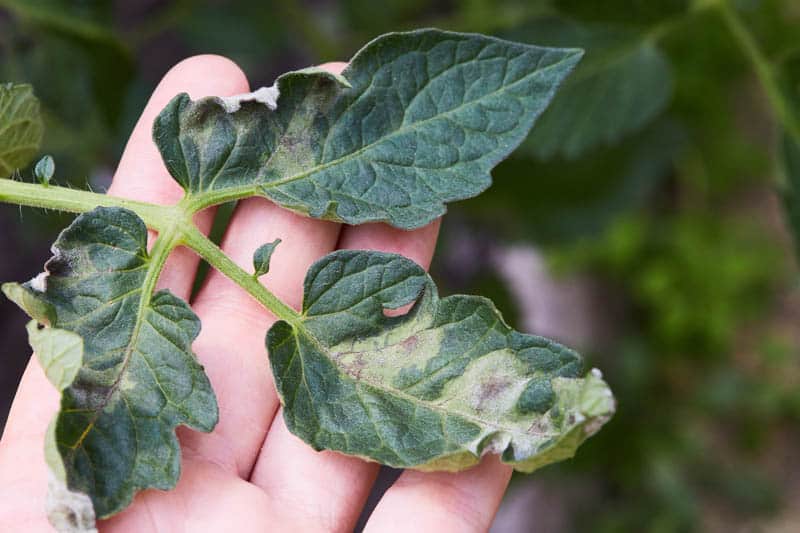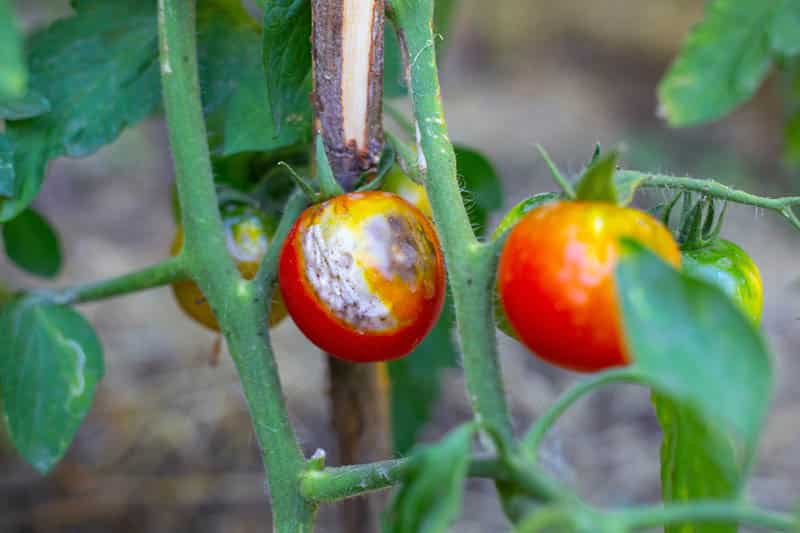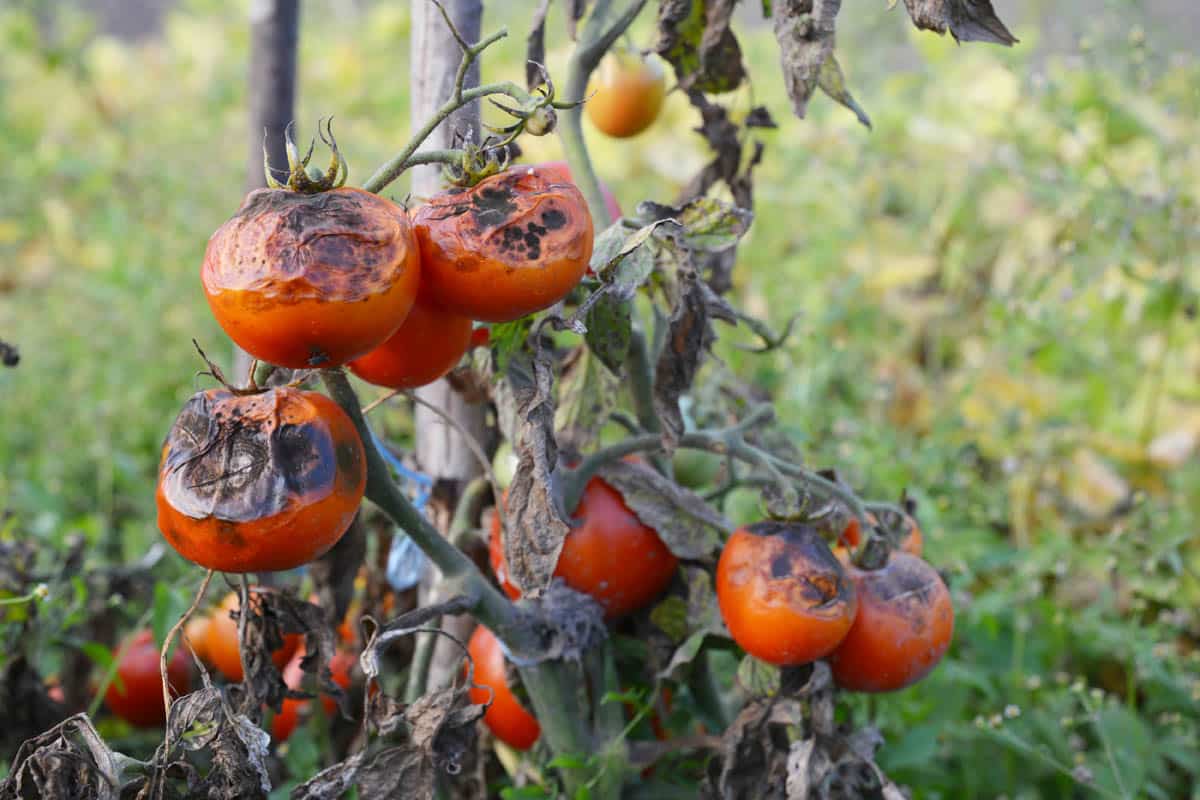What is tomato blight? Ι Transmission Ι Reproduction Ι What does tomato blight look like? Ι Treatment Ι Killing tomato blight in pots and soil Ι Difference between early and late blight Ι Prevention
What is tomato blight?
Also known as late blight, tomato blight is a highly contagious and destructive disease caused by Phytophthora infestans, a fungus-like organism (Oomycete) within the Kingdom of protists. Affected plants include potatoes, tomatoes and to a lesser extent eggplant and petunias. Tomato blight was responsible for the Irish Potato Famine in the 1800s which killed 1 million people and is one of the most significant plant diseases, with a worldwide economic cost of US $5 billion annually.
There are three types of blight in tomatoes. Septoria leaf spot, early blight and late blight. This article refers specifically to late blight.
P. infestans has a worldwide distribution, thriving in cool areas with high rainfall. There are two types of tomato blight, A1 and A2. Each type is able to asexually reproduce and sexually reproduce, resulting in the exchange of genes and leading to new strains that are resistant to fungicides and resistant cultivars.
The name Phytophthora is derived from the Greek word phyto = plant, and phthora = destroyer.
Transmission
Transmission occurs when fungus-like water mould spores known as sporangia are dispersed by wind, wind-driven rain, or splashing raindrops from an infected plant. P. infestans is a necrotrophic parasite, spores penetrate the foliage, growing into a dark lesion, which in turn contains thousands of new spores and spreads to new plants within the Solanaceae family. All above-ground parts of the plant are affected including the leaves, stems and fruit.
Reproduction
Sporangiophores are stalks with a flattened disk at the tip that release thousands of sporangia, which are asexual spores. These sporangia are carried by the wind to their host plants, and when they land on plant tissue that is covered with a film of water, they can penetrate the plant via the stoma or form a penetration peg to penetrate the epidermis.
Once inside the plant, the fungus produces mycelium, which are root-like structures that secrete proteins and peptides known as effectors. Effectors target the extracellular space and subcellular compartments of the plant, suppressing its natural defenses and destroying plant cell walls, resulting in characteristic lesions.
What does tomato blight look like?

Tomato blight affects the leaves, fruit and tubers of both tomato and potato plants and occurs late in the growing season (around August in the Northern Hemisphere) in temperatures above 10 degrees centigrade, and in high humidity (almost 100%). Visible signs appear approximately three days after infection and kill the plant within days.
- Areas of rapidly enlarging irregularly shaped lesions on the leaves, especially after periods of wet weather. These may appear water soaked in wet weather, in dry weather, the centre will dry out. The lower leaves are usually affected first before lesions rapidly spread to the stems and higher leaves.
- Lesions appear on the fruit as dark, greasy spots, secondary organisms can then invade the fruit, leading to soft rot.
- As the infection progresses, the leaf, stem, fruit and tubers develop a white fuzzy appearance when the organism reproduces, and eventually collapses.

Treatment
- Chlorothalonil: This fungicide is works by preventing the growth of fungal spores and can be applied as a foliar spray or soil drench.
- Copper-based fungicides: Copper sulfate and copper hydroxide, are effective against tomato blight. They can be applied as a foliar spray or soil drench, and they work by killing the fungal spores.
- Mancozeb: Mancozeb is a broad-spectrum fungicide that can be used to prevent and control tomato blight. It works by interfering with the metabolic processes of the fungus, preventing it from growing and reproducing.
- Azoxystrobin: A systemic fungicide that can be applied as a foliar spray. It works by inhibiting the respiratory processes of the fungus, leading to its death.
Killing tomato blight in pots and soil
Phytophthora infestans can survive on plant debris including potato tubers, fruit, leaves, and stems of infected plants. Oospores can survive in soil and any remaining plant matter left behind.
Infected tomato plants in containers should be carefully disposed of, along with the potting mix. If the pot is to be reused, it will need to be sterilised.
Sterilising pots
- Clean any debris remaining on the pot with soapy water, this stem is important as bleach is deactivated in the presence of organic matter
- Allow the pots to air dry
- Make a solution of 1 part bleach to 10 parts cold water and soak the pot for a minimum of ten minutes
- Remove pots from the bleach solution and thoroughly rinse in water
Killing tomato blight in soil
Solarisation can be used to kill tomato blight in bedding soil. This chemical-free method utilises high temperatures from sunlight to kill soil-borne pathogens and is most effective when carried out during the summer months.
Solarisation method
- Clear the area of rocks, debris and plants
- Turn over the soil so that it is crumbly and then rake until the soil is smooth
- Soak the area with water making sure to not leave any uneven layers in the soil
- Measure out the area to be solarised
- Place thick clear plastic over the entire area, being careful not to leave any air pockets to ensure the heat is retained
- Bury the edges of the plastic to prevent them from being dislodged in windy conditions.
- Remove the plastic after 6 – 8 weeks
Difference between early and late blight
Early blight is caused by the fungus Alternaria solani and affects plants in warm and humid climates. Affected plants develop a characteristic bullseye on the foliage as well as lesions on the stems, fruit and tubers. Late blight is caused by the oomycete Phytophthora infestans and infects plants in damp and cool conditions. Both A. solani and P. infestans infect members of the Solanaceae family.
Both A. solani and P. infestans infect members of the Solanaceae family, which includes plants like tomatoes, potatoes, and peppers.
Prevention
| Drainage | Plant tomatoes in locations with good drainage to help prevent excess moisture. |
| Mulch | This not only reduces the need to water as often but also helps prevent splash-up from rain and watering |
| Space plants apart | Ensure there is plenty of space between tomato plants to allow for good airflow and reduce the risk of tomato blight spreading to other plants. |
| Be careful when bringing tomato plants/cuttings etc., into your garden |
Make sure you choose healthy-looking plants with no signs of disease. |
| Choose resistant cultivars | Tomato plants that carry Ph-2 and/or Ph-3 genes have been found to be resistant to tomato blight. Research from Cornell University found the following species of tomato the most resistant to tomato blight; Mountain Magic, Jasper, Regal Plum, Legend, Juliet, Pruden’s Purple, Aunt Ginny’s Purple, Black Plum, Brandywine, Tigerella, and Matt’s Wild Cherry. |
| Select early season cultivars | Most tomatoes mature 70 – 80 days to reach maturity, while early season varieties only take 55-65 days. Providing adequate nutrition can also speed up the growth of seedling tomatoes. |
| Grow in greenhouses | It is easier to protect tomatoes from rain in greenhouses. It is important to ensure is well-ventilated to keep humidity down. |
| Prune | Trim the foliage and side shoots of tomatoes to increase airflow. |
| Provide adequate support | A tomato cage or stake should be used to support the tomato plant and keep its leaves off the wet ground. |
| Fungicides | Fungicides containing chlorothalonil or copper can be used on plants to prevent tomato blight, but are unable to treat the disease. |
| Check for signs of tomato blight | Regularly check all tomato plants for signs of tomato blight and immediately remove and carefully dispose of any plants showing signs of infection. |
Julia is a writer and landscape consultant from Wollongong with a love of horticulture. She had been an avid gardener for over 30 years, collects rare variegated plants and is a home orchardist. Julia is passionate about learning and sharing her knowledge of plant propagation and plant toxicology. Whether it’s giving advice on landscape projects or sharing tips on growing, Julia enjoys helping people make their gardens flourish.




